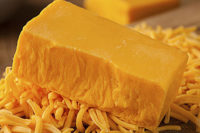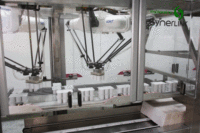
Full Speed Ahead
by Lynn Petrak
Contributing Editor
Trailers, trucks and reefers move products along more rapidly, safely and efficiently.
It’s not enough to get product from Point A to Point B anymore. For one thing, Point B has given way to Points C, D and E, as a greater variety of retail and foodservice channels mean more places to which dairy companies must ship.
For another, dairies continue to develop more diverse
product lines that are refrigerated, frozen and, in some cases, shelf
stable. Add to that the dual drumbeats of food safety and fuel economy, and
it becomes clear that navigating the cold chain isn’t a straight shot
anymore.
The changing landscape of transporting perishable
consumable goods has certainly affected modes of transportation. Trailers,
trucks and reefers have continued to evolve to accommodate changes in the
food and beverage industries, including the dairy sector.
Some of those profound changes are organizational.
“The whole industry has gone through major consolidations, and as
larger companies are buying out smaller dairies, they to go a much longer
distance,” says Adriano Melluzzo, vice president of industry sales
for Miami-based Ryder System Inc., which offers transportation management
and dedicated contract carriage, among other logistics and transportation
solutions. “So a lot of these companies are going to tractor/trailer
combinations in lieu of straight trucks.”
Mergers and acquisitions are not unique to the dairy
industry, either. “Because of consolidation in the truck-body
industry over the past decade, many of the companies the dairy industry
would have purchased an insulated truck body from in the past have either
gone out of business or been purchased by their larger competitors or
holding companies and changed at an elemental level,” says Jeffrey
Caddick, purchasing manager for Henderson, Ky.-based insulated and dry
dairy equipment provider Hercules Manufacturing, adding that as result,
dairies are looking at wider range of options. “We built what our
customers want. While we consider ourselves smart about building truck
bodies, we also recognize and respect that our dairy customers know about
delivering milk and ice cream.”
As dairies, consolidated or not, become increasingly
competitive, versatility has become another key contributor to the way
products are transported. “In the dairy industry, you have more
companies carrying more products; dairies are loading things like yogurts,
ice creams and juices. Although most are still single temperature
operations, we are seeing more dairies coming in with multi-temperature
trailers with multiple side doors,” says Tracey Maynor, vice
president, branch sales and operations for Great Dane Trailers, Atlanta.
Melluzzo, too, says dairies are looking at broader
temperature capability. “They are trying to minimize and utilize
their fleet as much as they can. That’s why you have dual-temp and,
in some cases, multi-temp with three compartments,” he says.
Also tied into the climate of competition, trucks
today are often used for more than just hauling. Brian Scales, president of
Canada’s Drake Truck Bodies, points to advances like bonded wall
panels that use advanced glue instead of rivets to give walls a smooth,
clean look and allow for the easy application of full-size decals.
“Dairy companies are finding value using their truck bodies and
trailers as marketing media,” he says. “Increasingly, these
companies will decal the entire side of the truck body or trailer with
their company logo or marketing message.”
To be sure, there are other industry realities that
have resulted in innovations in designs of trailers, trucks and reefers.
Driver safety and ease of use, for example, are on the wish list of many
dairy operations. “In the dairy industry, they are looking for bodies
designed and equipped to make them easier for the driver to get into and
back out of, thus decreasing workers comp claims,” Caddick says.
Advances in interior features like flooring have also
emerged in recent years. “We have made an effort to design a floor
specific to the dairy industry, which has a textured top that allows dairy
cases to slide easily and provides a driver with an anti-slip
surface,” Maynor says.
Lifts, too, have been a focus of continual
improvements. Scales, for instance, cites Drake’s recent development
of a Slick Lift. “This lift gate is unique because the platform is
part of the truck body floor. It is also a ‘direct lift,’ using
two low-maintenance hydraulic cylinders,” he explains, listing
benefits like quicker delivery times, lower worker compensation claims,
reduced injury and increased productivity.
Issues and Innovations
In addition to new trailer, truck and reefer designs
that stem from daily business realities, other dairy industry trends impact
what and how products are hauled.
Food safety is one of those key trends. Maynor says
Great Dane works with dairy customers to ensure insulation is effective for
the protection of frozen or chilled products. He cites the company’s
recent development of ThermoGuard, a glass-reinforced thermoplastic lining
for reefer interiors that reduces the outgassing effects of insulation.
Improving insulation also has been a focus at
Hercules, which offers pressure foaming in fixtures through foam guns with
ratio monitors that serve to virtually eliminate the possibility of foam
voids. “The ratio monitors prevent you from shooting another shot if
your gun is performing off ratio, which means that 100 percent of the time,
we are shooting good foam,” Caddick says. “Bad foam degrades
quicker, compromising insulating value.”
Effective seals also keep out moisture and allow for
correct refrigeration and freezing. “Things like copper seals around
the doors are important for product integrity,” Maynor says, adding
that Great Dane offers a dual-seal setup on its side doors.
Last year, Johnson Truck Bodies, a Rice Lake,
Wis.-based division of the Carlisle Co., made its new TripleSeal door
gaskets standard on its refrigerated truck bodies, a component that limits
heat and moisture transfer to interiors.
Puncture guard features, on areas like sidewalls, are
another relatively new example of safety-driven innovations, Melluzzo says,
adding that more advanced coatings help prevent moisture from reaching the
interior.
Tools that regulate temperature also help ensure
product integrity and safety. “One thing that has become very
much in demand lately has been the use of data loggers, because of the
concern of food safety,” Melluzzo says.
Meanwhile, just as food safety is a top-tier issue for
dairies, so too is fuel economy, especially in the light of current
environmental, geopolitical and economic situations. “I am getting a
lot of requests, because of fuel crunches, for hybrid refrigeration
units,” Melluzzo says.
Meanwhile, Maynor says advances like Great
Dane’s ThermoGuard were developed not only for product integrity but
for fuel efficiency. “The big thing to happen in fuel economy as far
as a trailer goes is ThermoGuard — that will absolutely save fuel
units,” he says.
Scales points to Drake’s latest B-Train trailer
system as a development that centers on efficiency. “It allows one
truck to haul two trailers, saving the fuel and costs associated with a
second truck,” he says.
Road Tech
Increasingly, trucks are equipped with computers and
other electronics that enable users to track products, drivers and regulate
or evaluate the environment.
Melluzzo says Ryder has been working on innovations in
this area. “One of the things that we’ve been piloting over the
last few months is an onboard computer system called RydSmart, with an
onboard computer and GPS. It is a fleet information tool that allows you to
get the road speed, miles per gallon and stops,” he says. In addition
to that pilot program, Ryder offers a web-based information center that
acts as a virtual fleet manager.
Lighting, too, is more sophisticated. “LED
lights, both exterior and interior, really taken off in the last few years.
They are more reliable than incandescent or fluorescent light and will live
longer and are not as susceptible to damage and vibration,” Maynor
says.
Adds Caddick: “Lately, the most popular options
are either fluorescent or LED strip lighting for the interior, and LED
lighting for the exterior.”
Maintenance Plans
The choice of materials is one way to extend the life
of a truck, trailer or reefer body. Johnson Truck Bodies recently switched
to stainless-steel hardware as an option for new truck bodies or for
replacement parts, because stainless offers a longer usable life than
traditional chrome or powder-coated hardware.
Protection against corrosion is another way that dairy
transporters can get more out of their existing bodies.
Great Dane is set to introduce a new corrosion
protection called CorroGuard, to be available on suspensions and support
gears of all of its trailers.
Fleet maintenance and management programs are
available as well, if dairies need to outsource any work. Ryder, for its
part, offers an expansive program that also includes the use of rentals.
Lynn Petrak is a freelance journalist based in the
Chicago area.
$OMN_arttitle="Full Speed Ahead";?>
$OMN_artauthor="Lynn Petrak";?>
